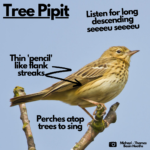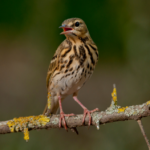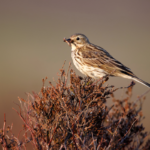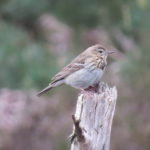Tree Pipit

Back Nightjar Dartford Warbler Woodlark Stonechat Linnet Tree Pipit
TREE PIPIT
Anthus trivialis
Tree Pipits have a brown streaky plumage pattern, with a white belly and a buff/yellowy coloured breast, again with streaks. You must look very carefully to make sure it’s not a Meadow Pipit! They have an amazing song flight where they jump from a tree singing, then climb upwards, still singing, then suddenly parachute down with wings spread out to usually land in a different tree from the one they started from.
- Tree pipit
- Tree pipit
- Tree pipit © Michael Jones
[Click on the thumbnails to open]
Where/when to find them
Found in very open heaths with scattered trees and other similar habitats. They use the trees for launching their exceptionally beautiful song and as look outposts!
Adaptations
Tree Pipits are long distance migrants. They fly to Africa every winter as the supply of insects in the UK dries up!
Diet
Mainly insects found on the ground.
Rarity
Tree Pipits are an unusual bird to see, as they’re very shy, often going unnoticed. Unfortunately, they are also declining in numbers. Under the traffic light system of Birds of Conservation Concern, they are ‘red’ listed (i.e. of the highest conservation priority), with the species needing urgent action to reverse its decline. This may be due to changes abroad, as they migrate from Africa to breed here in spring and go back again in autumn.
Read more
Birding beginnings: Parachuting pipits
#MoreThanJustNightjars




